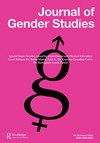女孩在数字空间变得“性感”:能力与限制
IF 1.5
3区 社会学
Q2 SOCIAL ISSUES
引用次数: 0
摘要
本文章由计算机程序翻译,如有差异,请以英文原文为准。
Girls becoming ‘sexy’ on digital spaces: capacities and constraints
ABSTRACT In this paper, we draw upon a qualitative study to investigate how black teenage girls interact with digital spaces to provide both capacities to express and constrain sexuality. Following a new feminist materialist approach, we demonstrate girls’ experiences of sexuality as embedded within a complex entanglement of matter (both human and more-than-human) that produce capacities, mediating what girls can do, feel or be on social media. Specifically, we conceptualize girls’ experiences within a ‘techno-sexual’ assemblage of bodies, things, ideas, social media applications, videos and pictures to illustrate how ideals of heterosexuality are connected to an affective flow of matter that creates vibrancy, permitting capacities and constraints. Firstly, we show how girls’ entanglement with celebrity and media culture, sexy selfies, and videos through digital affordances unlocked agentive capacities for the experience of heterosexual desire. Secondly, we illuminate how the assemblage generated restrictive capacities for girls who did not ascribe to heteronormative and racialized ideals of beauty through objectification and online sexual harassment. We argue that a recognition of this online micro-political space remains a vital part of gender transformative interventions.
求助全文
通过发布文献求助,成功后即可免费获取论文全文。
去求助
来源期刊

Journal of Gender Studies
Multiple-
CiteScore
4.40
自引率
0.00%
发文量
52
期刊介绍:
The Journal of Gender Studies is an interdisciplinary journal which publishes articles relating to gender from a feminist perspective covering a wide range of subject areas including the Social and Natural Sciences, Arts and Popular Culture. Reviews of books and details of forthcoming conferences are also included. The Journal of Gender Studies seeks articles from international sources and aims to take account of a diversity of cultural backgrounds and differences in sexual orientation. It encourages contributions which focus on the experiences of both women and men and welcomes articles, written from a feminist perspective, relating to femininity and masculinity and to the social constructions of relationships between men and women.
 求助内容:
求助内容: 应助结果提醒方式:
应助结果提醒方式:


